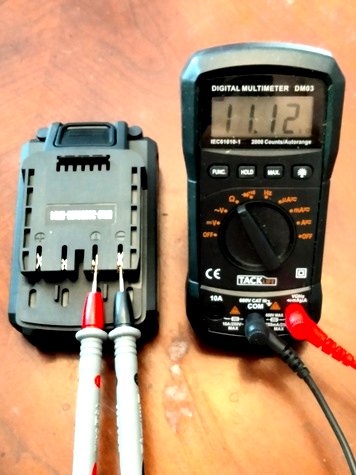
Older Revision of Hyper Tough 20V MAX Power Tools Battery Interface
Hyper Tough 20V MAX Power Tools Battery InterfaceThe Hyper Tough 20V MAX power tool uses 20-volt lithium ion (Li-Ion) battery packs. The battery packs probably contains five 3.6v lithium ion power cells that provides 18v and peaks at 20v when charged. Hyper Tough 20V MAX Battery Pin-OutThe photo below shows the pin-out on the battery. 
Hyper Tough 20V MAX Slide-On Charger Pin-OutThe photo below shows the pin-out on the slide-on charger. 
As you can see from the photo above, during charging, only the negative pin and the unmarked pin are connected. Hyper Tough 20V MAX Power Tool Pin-OutThe Hyper Tough 20V MAX power tool interfaces with the +, T, and - terminals on the battery. But when we masked out the T terminal on the Hyper Tough 20V Max 8" 2.0Ah 20V Battery Powered Cordless Pole Saw, we have found that the pole saw still operated. This means that it will be really easy to interface any other brand's 18V/20V lithium ion battery pack with some Hyper Tough power tools. Resistance Measurement on the BatteryIt's possible that other Hyper Tough power tool may utilize the T pin for identification. So we measured the resistance of the Hyper Tough battery and present it below: 
As you can see above, the negative and the T terminal has 11.12 kilo-ohms resistance. Whether this information is useful or not, we don't know, because we don't have a Hyper Tough tool that needs it. But if it does help you, please feel free to let us know in the comments. In most cases, it's the T terminal and the negative terminal that's important. After all, the negative terminal serves as ground or common. But in rare cases where the positive terminal is connected to the T terminal, we present the resistance measurement below: 
Based on the resistance measurement, the positive terminal is not connected to the T terminal at all. Related Links
|
Articles
|
Wiki
486 Users Online 
|
|
Copyright © 2004 - 2024. All Rights Reserved. |